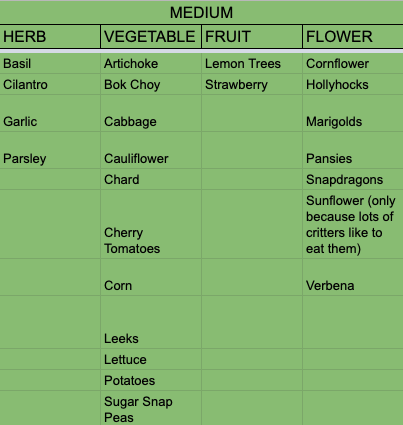Selecting Plants for Your School Garden
By Naomi Stern
One of the most common questions I receive from educators is: What should I plant in my school garden? If this sounds like you, you’ve found the right blog post!
School gardens have unique challenges that make plant selection difficult, especially for novice gardeners. Before you choose what to plant it’s important to assess your growing space. Here are some things to consider before planting:
Climate: What are the unique growing conditions at your site? Every school has a microclimate. Here in the San Francisco Bay Area we have a Mediterranean climate, meaning dry summers and mild/wet winters. These are great conditions for growing food! Your microclimate can vary if you are on the coast or in a hilly area. It is important to choose plants or plant varieties that will do well in your school’s garden.
Time: How much time do you and your school garden champions have to dedicate to the garden? With a lot of time, you might be able to take on more challenging plants. If you are more limited, it is best to consider lower-maintenance garden plants.
Note: The school calendar year makes growing some plants more challenging. Summer break is when many crops are either ready to harvest or need watering. If your garden champion has limited availability in summer, considering growing shorter season crops in spring and fall.
Cost: Buying plants can get expensive, especially from nurseries. Seeds are much less expensive, but take more effort to grow. Having a plan for what you want to grow will help reduce the cost of purchasing plants.
Goals/Theme of Garden: What is the main goal of your garden? Having a defined theme will help you in selecting plants. Some theme ideas include: Vegetable, Herb, Native Plant, Pollinator, the list goes on!
Every garden is different. Try, and if you don’t succeed, try, try again! Luckily with gardens we can always start fresh and every growing season is an opportunity to begin anew.
I’ve organized my growing chart into Mild, Medium, and Spicy. Mild are easy to grow plants that are highly likely to be successful in any school garden. Medium and Spicy will require more skill or time to manage, but come with delicious and/or beautiful rewards!
More resources to explore:
“The Growing Classroom: Garden-Based Science” by Roberta Jaffe and Gary Appel
“How to Grow more Vegetables” by John Jeavons
“Golden Gate Gardening” by Pamela Pierce
—
Naomi was our Programs Manager for four years. She began teaching as an undergraduate at U.C. Santa Cruz. After receiving her degree in Environmental Studies, she was a Programs Instructor for The Youth Garden Project. Naomi is grateful to teach students about the power of healthy food and responsible farming.



